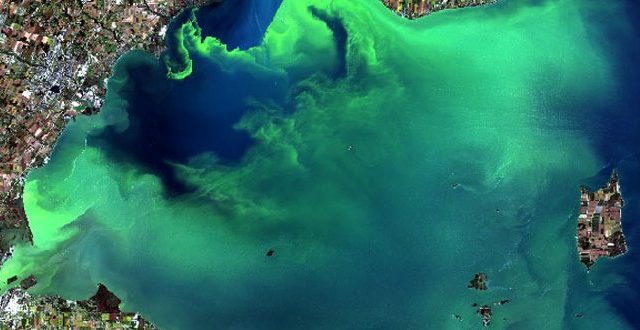Large algae bloom in Lake Erie predicted for 2019

Photo: Western Lake Erie and an algae bloom as seen from a Landsat-8 satellite in September 2017. (NASA/USGS)
NOAA and its research partners are predicting that the western Lake Erie will experience a large harmful algal bloom (HAB) this summer.
This year’s bloom is expected to measure 7.5 on the severity index, but could possibly range between 6 and 9. An index above 5 indicates blooms having greater impact. The severity index is based on bloom’s biomass — the amount of algae — over a sustained period. The largest blooms occurred in 2011 and in 2015 with severity indexes at 10 and 10.5.
Lake Erie blooms consist of cyanobacteria, also called blue-green algae, that are capable of producing the liver toxin microcystin that poses a risk to human and wildlife health. These algal blooms may result in higher costs for cities and local governments that need to treat drinking water, prevent people from enjoying outdoor water recreation such as fishing, swimming, boating and visiting the shoreline, and harm the region’s vital summer tourism economy. These effects will vary in location and severity due to winds that may concentrate or dissipate the bloom.
Communities along Lake Erie rely upon clean water to support their well-being and economic livelihoods.
This year, the lake temperature has remained relatively cool due to the higher-than-average rainfall in the region, so the bloom is not expected to start until late July when the water temperature reaches 65 to 70 degrees F. This contrasts with 2018, when exceptionally warm weather at the beginning of June caused an early start. Calm winds in July, especially in western Lake Erie, tend to allow the algal toxins to concentrate, making blooms more harmful. The bloom typically peaks in the western part of the lake in September. Most of the rest of the lake will not be affected.
Christopher Winslow, director of Ohio’s Sea Grant says “Despite the predicted size of this year’s bloom, portions of the lake will be algae free during the bloom season and the lake will remain a key asset for the state. Ongoing research continues to help us understand bloom movement and toxin production, and remains vital to providing our water treatment facilities with the tools, technology and training they need to keep our drinking water safe.”
NOAA continues to expand the use of satellite data into its Lake Erie Harmful Algal Bloom Forecast System, which is helping improve the accuracy of bloom forecast products. The data comes from the European Union’s Copernicus Sentinel-3 satellite, which has instruments that measure coastal water color, and have proven to be especially useful for detecting and tracking algal blooms. NOAA is also continuing to work with its research labs and academic partners to refine and improve the models used to develop the forecasts.
“This spring brought regular, heavy rainfall to the Maumee River watershed which would normally carry a lot of nutrients into the lake,” said Richard Stumpf, Ph.D., NOAA’s National Centers for Coastal Ocean Science’s lead scientist for the seasonal Lake Erie bloom forecast. “However, due to the amount of rain this year, farmers were unable to plant their fields which reduced the nutrient concentration. That combined with higher than normal lake levels, presents an opportunity to test the accuracy of our models.”
This post was modified from the original article, found here.
